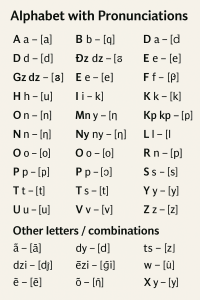The Ewe Alphabet and Language
Ewe is a member of the Volta–Niger branch of the Niger–Congo languages. It is spoken by about 5.5 million people, mainly in Ghana, and also in Togo and Liberia.
- In Ghana, there are about 3.8 million speakers, particularly in the Eastern Region and the Volta Region.
- In Togo, there are about 1.7 million speakers, mostly in the Maritime and Plateaux Regions.
- In Liberia, about 3,560 people speak Ewe.
- There many ewe Speakers also in Nigeria
 Ewe is also known by many other names, including: Éwé, Ebwe, Efe, Ehwe, Eibe, Eue, Eve, Gbe, Krepe, Krepi, Popo, and Vhe. Its dialects include Anglo, Awuna, Hudu, and Kotafoa. Ewe is closely related to other Gbe languages such as Fon, Gen, Phla, Phera, and Aja.
Ewe is also known by many other names, including: Éwé, Ebwe, Efe, Ehwe, Eibe, Eue, Eve, Gbe, Krepe, Krepi, Popo, and Vhe. Its dialects include Anglo, Awuna, Hudu, and Kotafoa. Ewe is closely related to other Gbe languages such as Fon, Gen, Phla, Phera, and Aja.
A bit of history
The Ewe people believe their ancestors came from Ketu, a town in Benin and settled in Notse, a town in Togo. Some years later due to their wicked king Agorkoli, some couldn’t stand him . Hence a group of them decided later migrated to southeastern Ghana; the current Volta and Oti regions.
The German missionary linguist Diedrich Hermann Westermann (1875–1956) played an important role in documenting the language in Togo. The first written was done in Togo by him. He published dictionaries and grammars for Ewe, and since then, many other linguists have studied Ewe in depth. Ewe is the first official local recognized language in Ghana. It’s been thought many of their schools from primary to universities and well spoken in national medias.
Ewe is also officially recognized in Ghana. It is taught in primary and secondary schools, used in literature and the media. Since the 1850s, it has been written with the Latin alphabet, though different spelling systems have been used over the years.
The Ewe Alphabet with Pronunciations
- A a – [a]
- B b – [b]
- D d – [d]
- Đ ɖ – [ɖ]
- Dz dz – [ʣ]
- E e – [e]
- Ɛ ɛ – [ɛ]
- Ə ə – [ə]
- F f – [f]
- Ƒ ƒ – [ɸ]
- G g – [g]
- Gb gb – [gb͡]
- Ɣ ɣ – [ɣ~ʁ]
- H h – [h]
- I i – [i]
- K k – [k]
- Kp kp – [kp͡]
- L l – [l]
- M m – [m / m̩]
- N n – [n]
- Ny ny – [ɲ]
- Ŋ ŋ – [ŋ]
- O o – [o]
- Ɔ ɔ – [ɔ]
- P p – [p]
- R r – [r]
- S s – [s]
- T t – [t]
- Ts ts – [ʦ]
- U u – [u]
- V v – [v]
- Ʋ ʋ – [β]
- W w – [w]
- X x – [x]
- Y y – [y]
- Z z – [z]
Other Letters / Combinations
- ã – [ã]
- dy – [d̡]
- dzi – [ʤi]
- ẽ – [ɛ̃]
- ĩ – [ĩ]
- ŋw – [ŋw͡]
- õ – [ɔ̃]
- si – [ʃi]
- ty – [ƫ]
- tsi – [ʧi]
- ũ – [ũ]
- zi – [ʒi]
Notes on Ewe Tones
Ewe is a tonal language with four tones:
- Rising tone → é (acute accent)
- Falling tone → è (grave accent)
- Falling–rising tone → ě (caron accent)
- Rising–falling tone → ê (circumflex)
These tones are not always marked in writing, but they are essential in spoken Ewe.
